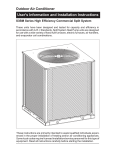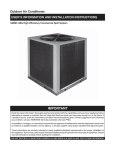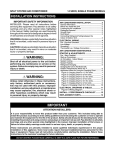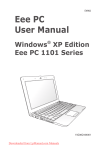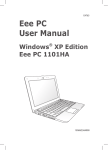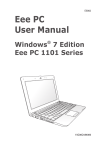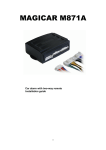Download Nordyne T3BN User's Manual
Transcript
Outdoor Heat Pump User’s Information and Installation Instructions T3BN Series High Efficiency Commercial Split System These units have been designed and tested for capacity and efficiency in accordance with A.R.I. Standards. Split System Heat Pump units, when combined with our air handlers, offer a high quality, matched heating and cooling system. These instructions are primarily intended to assist qualified individuals experienced in the proper installation of heating and/or air conditioning appliances. Some local codes require licensed installation/service personnel for this type of equipment. Read all instructions carefully before starting the installation. OPERATING INSTRUCTIONS TO OPERATE YOUR HEAT PUMP FOR COOLING — 1. Set the thermostat system switch to COOL and the thermostat fan switch to AUTO. (See Figure 1) 2. Set the thermostat temperature to the desired temperature level using the temperature selector. Please refer to the separate detailed thermostat user’s manual for complete instructions regarding thermostat programming. The outdoor unit and indoor blower will both cycle on and off to maintain the indoor temperature at the desired cooling level. 2. Set the thermostat temperature to the desired temperature level using the temperature selector. Please refer to the separate detailed thermostat user’s manual for complete instructions regarding thermostat programming. The outdoor unit and indoor blower will both cycle on and off to maintain the indoor temperature at the desired heating level. NOTE: If the thermostat temperature level is re-adjusted, or the thermostat system switch is repositioned, the outdoor unit may not start immediately. The outdoor unit contains a protective timer circuit which holds the unit off for approximately five minutes following a previous operation, or the interruption of the main electrical power. Emergency Heat: NOTE: If the thermostat temperature level is re-adjusted, or the thermostat system switch is repositioned, the outdoor unit may not start immediately. The outdoor unit contains a protective timer circuit which holds the unit off for approximately five minutes following a previous operation, or the interruption of the main electrical power. TO OPERATE YOUR HEAT PUMP FOR HEATING — 1. Set the thermostat system switch to HEAT and the thermostat fan switch to AUTO. (See Figure 1) SYSTEM MODE The thermostat includes a system switch position termed EM. HT. This is a back-up heating mode to be used only if there is a suspected problem with the outdoor unit.With the system switch set to EM. HT. the outdoor unit will be locked off, and supplemental heat (typically electric resistance heating) will be used as a source of heat. Sustained use of electric resistance heat in place of the heat pump will result in an increase in electric utility costs. Defrost: During cold weather heating operation, the outdoor unit may develop a coating of snow and ice on the heat transfer coil. This is FAN SWITCH Figure 1. Typical Thermostat 2 TEMPERATURE SENSOR normal, and the unit will periodically defrost itself. During the defrost cycle, the outdoor fan will stop, and the compressor will continue to run and heat the outdoor coil, causing the snow and ice to melt. After the snow and ice have melted, some steam may rise from the outdoor unit as the warm coil causes some melted frost to evaporate. TO OPERATE YOUR HEAT PUMP FOR AUTOMATIC COOLING AND HEATING— 1. Set the thermostat system switch to AUTO and the thermostat fan switch to AUTO. (See Figure 1) Note: Thermostats will vary. Some models will not include the AUTO mode, and others will have the AUTO in place of the HEAT and COOL, and some will include all three. 2. Set the thermostat temperature to the desired heating and cooling temperature level(s). The outdoor unit and the indoor blower will then cycle on and off in either the heating or cooling mode of operation as required to automatically maintain the indoor temperature within the desired limits. TO SHUT OFF YOUR HEAT PUMP— Set the thermostat system switch to OFF and the thermostat fan switch to AUTO. (See Figure 1) The system will not operate, regardless of the thermostat temperature selector(s) setting. TO OPERATE THE INDOOR BLOWER CONTINUOUSLY— Set the thermostat fan switch to ON (See Figure 1). The indoor blower will start immediately, and will run continually until the fan switch is reset to AUTO. The continuous indoor blower operation can be obtained with the thermostat system switch set in any position, including OFF. The continuous indoor blower operation is typically used to circulate the indoor air to equalize a temperature unbalance due to a sun load, cooking, or fireplace operation. TO MAINTAIN YOUR HEAT PUMP— CAUTION: Be certain the electrical power to the outdoor unit and the furnace/air handler is disconnected before doing the following recommended maintenance. 1. Regularly: a. Clean or replace the indoor air filter at the start of each heating and cooling season, and when an accumulation of dust and dirt is visible on the air filter. Inspect the filter monthly. b. Remove any leaves and grass clippings from the coil in the outdoor unit, being careful not to damage the aluminum fins. c. Check for any obstruction such as twigs, sticks, etc. d. Certain models have external panels fabricated from a premium grade of steel designed to inhibit corrosion. For such units, if the unit is located in a coastal region or other area subjected to high concentrations of salt, then the unit should be hosed off after storms and monthly otherwise to maintain its new appearance. CAUTION: Do not over-oil, or oil motors not factory-equipped with oil tubes. The compressor is hermetically “sealed” and does not require lubrication. 2. Before Calling a Service Technician, Be Certain: a. The unit thermostat is properly set—see “To Operate Your Heat Pump for Cooling” and “To Operate Your Heat Pump for Heating.” b. The unit disconnect fuses are in good condition, and the electrical power to the unit is turned on. 3 Read Your Warranty Please read the separate warranty document completely. It contains valuable information about your system. GENERAL INFORMATION Read the following instructions completely before performing the installation. the instructions provided with the equipment prior to performing the installation and operational checkout of the equipment. Brazing Operations — Installation of equipment may require brazing operations. Safety codes must be complied with. Safety equipment (e.g.; safety glasses, work gloves, fire extinguisher, etc.) must be used when performing brazing operations. Outdoor Unit Section — Each outdoor unit is shipped with a refrigerant holding charge. NOTE: DO NOT USE ANY PORTION OF THE CHARGE FOR PURGING OR LEAK TESTING. WARNING: Ensure all electrical power to the unit is off prior to installing or servicing the equipment. Failure to do so may cause personal injury or death. Matching indoor coils and air handlers may be shipped with a small holding charge to pressurize them to keep out contaminants. To release the pressure, read the indoor section installation instructions carefully. SITE PREPARATION Liquid and Suction Lines — Fully annealed, refrigerant grade copper tubing should be used when installing the system. Refrigerant suction line tubing should be fully insulated. Unpacking Equipment — Remove the cardboard carton and User’s Manual from the equipment. Take care to not damage tubing connections when removing from the carton. Field Connections for Electrical Power Supply — All wiring must comply with current provisions of the “National Electrical Code” (ANSI/NFPA 70) and with applicable local codes having jurisdiction. The minimum size of electrical conductors and circuit protection must be in compliance with information listed on the outdoor unit data label. Inspect for Damage — Inspect the equipment for damage prior to installing the equipment at the job site. Ensure coil fins are straight and, if necessary, comb fins to remove flattened and bent fins. SAFETY CONSIDERATIONS Pressures within the System — Split system heat pump equipment contains liquid and gaseous refrigerant under pressure. Installation and servicing of this equipment should be accomplished by qualified, trained personnel thoroughly familiar with this type of equipment. Under no circumstances should the Homeowner attempt to install and/or service the equipment. Labels, Tags, Precautions — When working with this equipment, follow all precautions in the literature, on tags, and on labels provided with the equipment. Read and thoroughly understand 4 Preferred Location of the Outdoor Unit at the Job Site — Conduct a survey of the job site to determine the optimum location for mounting the outdoor unit. Overhead obstructions, poorly ventilated areas, and areas subject to accumulation of debris should be avoided. The outdoor unit should be installed no closer than 18 inches from the outside walls of the facility and in an area free from overhead obstructions to ensure unrestricted airflow through the outdoor unit. Facility Prerequisites — Electrical power supplied must be adequate for proper operation of the equipment. The system must be wired and provided with circuit protection in accordance with local building codes and the National Electrical Code. INSTALLING THE OUTDOOR UNIT Slab Mount — The site selected for a slab mount installation requires a stable foundation and one not subject to erosion. The slab should be level and anchored (if necessary) prior to placing the equipment on the slab. Cantilever Mount — The cantilever mount should be designed with adequate safety factor to support the weight of the equipment, and for loads subjected to the mount during operation. Installed equipment should be adequately secured to the cantilever mount and levelled prior to operation of the equipment. Roof Mount — The method of mounting should be designed so as not to overload roof structures nor transmit noise to the interior of the structure. Refrigerant and electrical line should be routed through suitably waterproofed openings to prevent water leaking into the structure. INSTALLING THE INDOOR UNIT The indoor section should be installed before proceeding with routing of refrigerant piping. Consult the Installation Instructions of the indoor unit (i.e.: air handler, furnace, etc.) for details regarding installation. CONNECTING REFRIGERANT TUBING BETWEEN THE INDOOR AND OUTDOOR UNIT General — Once outdoor and indoor unit placement has been determined, route refrigerant tubing between the equipment in accordance with sound installation practices. Refrigerant tubing should be routed in a manner that minimizes the length of tubing and the number of bends in the tubing. Refrigerant tubing should be supported in a manner that the tubing will not vibrate or abrade during system operation. Tubing should be kept clean of foreign debris during installation and installation of a liquid line filter drier is recommended if cleanliness or adequacy of system evacuation is unknown or compromised. Every effort should be made by the installer to ensure that the field installed, refrigerant containing components of the system have been installed in accordance with these instructions and sound installation practices so as to insure reliable system operation and longevity. The maximum recommended interconnecting refrigerant line length is 75 feet, and the vertical elevation difference between the indoor and outdoor sections should not exceed 20 feet. Consult long line application guide for installations in excess of these limits. Filter Dryer Installation — A filter dryer is provided with the unit and installed inside the outdoor unit. Optional Equipment — Optional equipment (e.g.: liquid line solenoid valves, etc.) should be installed in strict accordance with the manufacturer’s installation instructions. ELECTRICAL CONNECTIONS WARNING: Turn off all electrical power at the main circuit box before wiring electrical power to the outdoor unit. Failure to comply may cause severe personnel injury or death. Wiring Diagram/Schematic — A wiring diagram/schematic is located on the inside cover of the electrical box of the outdoor unit. The installer should become familiar with the wiring diagram/schematic before making any electrical connections to the outdoor unit. Outdoor Unit Connections — The outdoor unit requires both power and control circuit electrical connections. Refer to the unit wiring diagram/schematic for identification and location of outdoor unit field wiring interfaces. Control Circuit Wiring — The outdoor unit is designed to operate from a 24 VAC Class II control circuit. Control circuit wiring must comply with the current provisions of the “National Electrical Code” (ANSI/NFPA 70) and with applicable local codes having jurisdiction. Thermostat connections should be made in accordance with the instructions supplied with the thermostat, and with the instructions supplied with the indoor equipment. A typical commercial installation with a heat pump thermostat and air handler are shown on the next page. 5 Electrical Power Wiring — Electrical power wiring must comply with the current provisions of the “National Electrical Code” (ANSI/NFPA 70) and with applicable local codes having jurisdiction. Use of rain tight conduit is recommended. Electrical conductors shall have minimum circuit ampacity in compliance with the outdoor unit rating label. The facility shall employ electrical circuit protection at a current rating no greater than that indicated on the outdoor unit rating label. Refer to the unit wiring diagram for connection details. Minimum Circuit Ampacity — Electrical wiring to the equipment must be compatible and in compliance with the minimum circuit ampacity listed on the outdoor unit data label. Maximum Fuse/Circuit Breaker Size — Circuit protection for the outdoor unit must be compatible with the maximum fuse/circuit breaker size listed on the outdoor unit data label. Disconnect Switch — An electrically compatible disconnect switch must be within line of sight of the outdoor unit. This switch shall be capable of electrically de-energizing the outdoor unit. Optional Equipment — Optional equipment requiring connection to the power or control circuits must be wired in strict accordance with current provisions of the “National Electrical Code” (ANSI/NFPA 70), with applicable local codes having jurisdiction, and the installation instructions provided with the equipment. Optional Equipment (e.g.: liquid line solenoid valves, refrigerant compressor crankcase heater, etc.) should be installed in strict accordance with the manufacturer’s installation instructions. STARTUP AND CHECKOUT WARNING: Ensure electrical power to the unit is off prior to performing the following steps. Failure to do so may cause personal injury or death. Air Filters — Ensure air filters are clean and in place prior to operating the equipment. Thermostat — Set the room thermostat function switch to OFF, fan switch to AUTO, and adjust the temperature setpoint to its highest setting. Prior to applying electrical power to the outdoor unit, ensure that the unit has been properly and securely grounded, and that power supply connections have been made at both the facility power interface and outdoor unit. Outdoor Unit — Ensure the outdoor coil and top of the unit are free from obstructions and debris, and all equipment access/control panels are in place. Using extreme caution, apply power to the unit and inspect the wiring for evidence of open, shorted, and/or improperly wired circuits. COPPER WIRE SIZE — AWG (1% Voltage Drop) Supply Wire Length-Feet Supply Circuit 200 150 100 50 Ampacity 6 8 10 14 15 4 6 8 12 20 4 6 8 10 25 4 4 6 10 30 3 4 6 8 35 3 4 6 8 40 2 3 4 6 45 2 3 4 6 50 Wire Size based on N.E.C. for 60° type copper conductors. 6 Functional Checkout: CAUTION: If equipped with a compressor crankcase heater, wait 24 hours prior to performing a function checkout to allow for heating of the compressor crankcase. Failure to comply may result in damage and could cause premature failure of the system. Thermostat G R W 2C E O Y NOTE: Jumper between W2 and E is required when no OD T-Stat is used. C & W2 to be connected to Electric Heat. R R Y Y O O W1 W2 W2 C C G Air Handler Heat Pump OD Section Typical Heat Pump with Standard Air Handler 7 Indoor Blower — Set the thermostat function switch to COOLING and the fan switch to ON. Verify that the indoor blower is operating and that airflow is not restricted. Set the fan switch back to AUTO. Low-Pressure Switch — A low-pressure switch is factory-installed (see attached). This switch is located in the suction line internal to the outdoor unit. The switch is designed to protect the compressor from a loss of charge. Under normal conditions, the switch is closed. If the suction pressure falls below 5 psig, then the switch will open and de-energize the outdoor unit. The switch will close again once the suction pressure increases above 20 psig. Please note that the switch interrupts the thermostat inputs to the unit. Thus, when the switch opens and then closes, there will be a 5 minute short cycling delay before the outdoor unit will energize. Cooling — Gradually lower the thermostat temperature setpoint below the actual room temperature and observe that the outdoor unit and indoor blower energize. Feel the air being circulated by the indoor blower and verify that it is cooler than ambient temperature. Listen for any unusual noises. If present, locate and determine the source of the noise and correct as necessary. Short Cycle Protection — With the system operating in COOLING mode, note the setpoint temperature setting of the thermostat, and gradually raise the setpoint temperature until the outdoor unit and indoor blower de-energize. Immediately lower the setpoint temperature of the thermostat to its original setting and verify that the indoor blower is energized and that the outdoor unit remains de-energized. Verify that, after approximately 5 minutes, the outdoor unit energizes and that the temperature of the air supplied to the facility is cooler than ambient temperature. Heating — Lower the thermostat setpoint temperature to the lowest obtainable setting and set the thermostat function switch to HEATING. The indoor blower and outdoor unit should stop running. After a minimum of five minutes, increase the setpoint temperature of the thermostat to the maximum setting. Verify that the outdoor unit and indoor blower have energized. Feel the air being circulated by the indoor blower and verify that it is warmer than ambient temperature. Listen for any unusual noises. If present, locate and determine the source of the noise and correct as necessary. NOTE: Other sources for heating (i.e.: electric furnace, fossil fuel furnace, air handler with electric heat options, etc.) that interface with the unit should be functionally checked to verify system operation and compatibility. Refer to the installation instructions for this equipment and perform a functional checkout in accordance with the manufacturer’s instructions. Defrost Cycle Timer — The defrost cycle timer controls the accumulated run time interval of the hot gas defrost after the defrost sensor closes. It is located in the upper right corner of the defrost control board. Three interval settings are available: 30 minutes, 60 minutes, and 90 minutes. Time setting selection is dependent on the climate where the unit is being installed. The default defrost cycle timer is set to 30 minutes. To adjust the cycle time, move the jumper to cover the two pins directly adjacent to the desired cycle time. Example 1. Dry climate of Southern Arizona. A 90 minute setting is recommended. Example 2. Moist climate of Seattle, Washington. A 30 minute setting is recommended. High-Pressure Switch — A high-pressure switch is factory-installed and located in the liquid line internal to the outdoor unit. The switch is designed to protect the system when very high pressures occur during abnormal conditions. Under normal conditions, the switch is closed. If the liquid pressure rises above 425 psig, then the switch will open and de-energize the outdoor unit. The switch will close again once the liquid pressure decreases to 350 psig. Thus, when the switch opens and then closes, there will be a 5 minute short cycling delay before the outdoor unit will energize. DEFROST CONTROL BOARD OPERATION AND TESTING 1. Terminals “R”-”C” must have 24±V present between them in order for the time delay and defrost sequences to be operational. 8 2. Jumper the “T2”-”DFT” test pins. This will indicate to the board that the defrost T-stat is closed(if the compressor is running). Defrost T-stat is closed at 32° or below and is open at 68° or above. But it’s state is unknown if the temperature is between 32°F and 68°F. The defrost thermostat tells the board whether a defrost cycle needs to be started or terminated. With the DFT closed the unit will run for 30/60/90 minutes in heat mode and then defrost the outdoor coil. The defrost will turn off the outdoor fan, turn on the compressor and raise the coil temperature to 68°F. This will open the DFT and terminate the defrost. If the DFT does not open the defrost will end after 10 minutes. Speed up changes: Manually initiating a defrost will cause the compressor to run continually when entering defrost. 3. Defrost board speed-up. With compressor running in heat mode, next jump the “Test” pin to “C” on terminal strip. This will initiate a defrost test in 5, 10 or 15 seconds (This is determined by the 30, 60 or 90 minute defrost pin settings. The factory setting will be 30 minutes). Note that this will bypass the compressor off delay when the unit goes into defrost test and if left in defrost test, the delay will be bypassed when the test is terminated by the processor. If the jumper is removed before the test is over the processor will perform the remainder of a normal defrost. See step 2 above. Note: If jumper is left on the “Test” to “common” pins permanently, the defrost cycle will become inoperable. 4. Remove the jumpers. Note: The delay/no-delay pin concerns compressor operation during defrosts.The default setting is delay. Reciprocating compressors should only use this setting in conjunction with an approved hard start kit. Scroll compressors that have noise issues while going into or coming out of defrost should use this 30 second delay to reduce the defrost noise.To switch from no-delay to delay remove the pin from the “no-delay” pin location and shift it to the “delay” pin location. Normal defrost operation: To test normal defrost operation when the temperature is above 35°F, jumper “R” to “DFT” on the 624656 board and allow the unit to run for 30 minutes. Defrost will continue until the “R” to “DFT” jumper is removed or for 10 minutes. Remove the jumper. The 5 minute time delay feature can be shortened 1 time to 1 second by jumping the “Test” to “C” terminal. Remove the jumper and repeat as desired. Defrost Test Procedure for 624656 1. Jumper “T2” to “DFT” at the test terminals. 2. With unit running in heat mode, short the “TEST” terminal to the common terminal near it. This will speed up the board and cause it to enter defrost mode in 5/10/15 seconds depending on the defrost time selection. Compressor delay will not function during speed-up. 3. This test will end in 5 seconds if the “TEST”common short is not removed. 4. Remove both the short and the “T2” to “DFT” jumper to terminate the defrost cycle. The 30 second compressor delay should operate normally. 5. Test is complete, reset thermostat to home owner preference. 9 10 150 175 200 225 250 275 300 325 350 375 400 75 80 85 90 95 Remove refrigerant when above curve 105 110 Liquid Temperature (F) 100 7.5 Ton HP TXV Charging Chart 115 120 125 130 Add refrigerant when below curve 135 Refrigerant Charging Charts Liquid Pressure (psig) Liquid Pressure (psig) 150 175 200 225 250 275 300 325 350 375 400 75 80 85 90 95 Remove refrigerant when above curve 105 110 Liquid Temperature (F) 100 10 Ton HP TXV Charging Chart 115 120 125 130 Add refrigerant when below curve 135 Refrigerant Charging Charts 11 12 Suc. 20 Suc. 169 176 24 25 123 125 127 129 131 133 135 26 25 24 23 22 21 20 175 169 163 158 152 146 140 123 125 127 129 131 133 135 27 26 25 24 23 22 21 124 126 128 130 132 134 136 28 27 26 25 24 23 22 40 Liquid Disch. Suc. 50 Liquid Disch. 174 171 167 163 160 156 152 124 126 128 130 132 134 136 38 37 36 35 34 33 32 204 197 190 183 176 169 162 140 143 146 148 151 154 157 - Discharge temperatures greater than charted values indicates a refrigerant undercharge. - Rated Design Values. Suction Pressure will be lower than design value if indoor air flow, entering dry bulb, or entering wet bulb temperatures are lower than design. - Shaded Boxes indicate flooded conditions 60 Liquid Disch. 67 66 65 64 63 62 61 290 283 276 269 262 255 248 216 210 204 198 191 185 179 Ensure that the unit is operating properly per the heating functional checkout in these installation instructions. For line sets other than 15 feet add 9.0 oz. R-22 per additional 5 feet of 5/8 inch liquid line over 15 feet and remove 9.0 oz per 5 feet less than 15 feet of liquid line. Charge the system by weighing in 30 lbs R-22 refrigerant. This is the recommended charge for 5/8 inch 15 foot line set. 171 175 180 184 189 193 198 2. 241 234 227 220 213 206 199 Evacuate the refrigerant system. 57 56 55 54 53 52 51 1. 3. Suc. Press. Temp. Press. Press. Temp. Press. Press. Temp. Press. Press. Temp. Suc. *Note: All pressures are listed in psig. and all temperatures in deg. F. 175 170 165 160 156 151 146 30 Liquid Disch. PROCEDURE FOR CHARGING 10-TON HEAT PUMP IN HEATING MODE. 155 162 148 21 23 141 20 22 134 19 Liquid Disch. Press. Temp. Press. Press. Temp. Press. Press. Temp. Press. 10 Liquid Disch. Press Suc. Liquid Disch. 0 OUTDOOR TEMPERATURE (DEG. F) Suc. 7.5 Ton REFRIGERANT CHARGING CHART Heating Mode of Operation 13 C Y O W2 R E CAPACITOR R LPS CC RVS HPS CC CC LOGIC 3 DF1 L3 DEFROST CONTROL BOARD C T2 T1 Y 4 R 1 W2 1 O DFT DF2 2 L3 L1 COMPRESSOR L2 RELAY DFT C OUTDOOR FAN MOTOR S CCH LEGEND: FIELD WIRING LOW VOLTAGE HIGH VOLTAGE CC - Contactor Coil CCH - Crankcase Heat DFT - Defrost Thermostat RVS - Reversing Valve Selenoid LPS - Low Pressure Switch HPS - High Pressure Switch 1 5 2 OUTDOOR FAN MOTOR BLACK DEFROST BOARD OPERATION 4)With DFT closed and “Y” closed, compressor run time is 1)Closes during defrost. accumulated. Opening of DFT during defrost or interval Rating: 1 Amp. Max. period resets the interval to 0. 2)Opens during defrost. Rating: 2 HP. at 230 Vac Max. 5)Ground on location provided inside compressor terminal box. 3)Closed when “Y” is on. Open when “Y” is off. Provides “off ” delay time of 5 mins. when “Y” opens. LOW VOLTAGE TERMINAL T3 T3 CC L2 T1 3 6 4 C R S COMPRESSOR T2 T3 RELAY CCH L1 PURPLE ORANGE CAPACITOR GRAY YELLOW HARNESS RED HARNESS GRAY BLACK BLACK HARNESS BLACK L1 T1 L3 THREE PHASE FIELD SUPPLY L2 L3 L2 GRD L1 T3 T2 LOW PRESSURE SWITCH C T2 C Y Y DFT DF2 DF1 O W2 R E O W2 R DFT E REV VALVE HIGH PRESSURE SWITCH T1 BLUE BLUE BROWN DEFROST CONTROL BOARD BLACK GREEN RED CONTACTOR 1. Couper le courant avant de faire letretien. 2. Employez uniquement des conducteurs en cuivre 3. Ne convient pas aux installations de plus de 150 volt a la terre. ORANGE NOTES: 1. Disconnect all power before servicing. 2. For supply connections use copper conductors only. 3. Not suitable on systems that exceed 150 volts to ground. 4. For replacement wires use conductors suitable for 105°C 5. For supply wire ampacities and overcurrent protection, see unit data label. 6. Connect to 24 vac/40va/class 2 circuit. See furnace/air handler installation instructions for control circuit and optional Relay/Transformer Kits. BLACK Split System Heat Pump WHITE GRAM BLACK 7106060 Three Phase PHYSICAL AND ELECTRICAL SPECIFICATIONS / OUTDOOR UNITS 10.1 EER —High Efficiency — Three Phase Model No. T3BN- 090C 280/230-3-60 Volts-Phase-Hz Voltage Range (Min-Max) Electrical Data 187-253 090W 120C 120W 460-3-60 280/230-3-60 460-3-60 380/420-3-50 380/420-3-50 414-506 187-253 414-506 Total Amps 32.1 16.4 33.4 17.2 Min Circuit Ampacity 41.4 21.7 43 22.7 Delay Fuse Max. (1) 60 35 70 35 Wire Size/Max Length (AWG 60°C Cu) 4/100 8/100 4/100 8/100 Wire Size/Max Length (AWG 75°C Cu) 6/100 8/100 4/100 8/100 Area (ft^2) 31.94 31.94 31.94 31.94 Rows-FPI 2-16 2-16 2-18 2-18 Tube Dia. Volts-Phase-Hz 3/8” OD 280/230-3-60 Qty 1 Coil Fan Motor Component Data Fan Blade Compressor Data 3/8” OD 3/8” OD 3/8” OD 460-3-60 280/230-3-60 460-3-60 380/420-3-50 380/420-3-50 1 1 1 Horsepower 3/4 3/4 3/4 Full Load Amps 3.3 1.7 3.3 3/4 1.7 Dia./Pitch/#Blades 30/19/3 30/19/3 30/26/3 30/26/3 RPM/CFM (Max-Total) 825/7500 825/7500 825/8500 825/8500 Volts-Phase-Hz 280/230-3-60 460-3-60 280/230-3-60 460-3-60 Qty./Type 1 / Scroll 1 / Scroll 1 / Scroll 1 / Scroll RLA 28.8 14.7 30.1 15.5 LRA 195 95 225 114 Stages/Percent 1 / 100 1 / 100 1 / 100 1 / 100 Crankcase Heater Qty./Type 1 / Band 1 / Band 1 / Band 1 / Band Refrigerant Suction Line-Length/O.D. 0 - 15 ft. 1 1/8” 1 1/8” 1 1/8” 1 1/8” (Liq. Line All Lengths - 5/8” O.D.) Circuits (Qty) - 1 16 - 25 ft 1 3/8” (3) 1 3/8” (3) 1 3/8” (3) 1 3/8” (3) 26 - 75 ft. 1 3/8” (3) 1 3/8” (3) 1 3/8” (3) 1 3/8” (3) Refrigerant Charge Holding Charge 56 56 90 90 R-22 Ounces Total System with 15’ Line Set (2) 374 374 486 486 Weight Net 413 413 423 423 Approximate (lbs.) Ship 425 425 435 435 (1) HACR Type Circuit Breakers may be used. (2) Add 9.0 oz. of refrigerant per 5 feet of additional line set. (3) Requires a 1-3/8” to 1-1/8” reducer line to unit. ACCESSORIES — Condensing Unit Low Ambient Kit 913549A- Maintains system pressures during low ambient conditions. 14 COPPER WIRE SIZE — AWG (1% Voltage Drop) Supply Wire Length-Feet 200 150 100 50 Supply Circuit Ampacity 6 4 4 4 3 3 2 2 2 1 8 6 6 4 4 4 3 3 3 2 10 8 8 6 6 6 4 4 4 3 14 12 10 10 8 8 6 6 6 4 15 20 25 30 35 40 45 50 55 60 15 INSTALLER: PLEASE LEAVE THESE INSTALLATION INSTRUCTIONS WITH THE HOMEOWNER ¢708538G¤ 708538A 708538A (replaces 7085380) Specifications and illustrations subject to change without notice and without incurring obligations. Printed in U.S.A. (08/08)
















